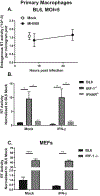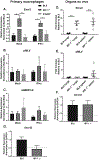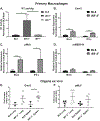Tumor suppressor Interferon Regulatory Factor 1 selectively blocks expression of endogenous retrovirus
- PMID: 30342302
- PMCID: PMC6875439
- DOI: 10.1016/j.virol.2018.10.003
Tumor suppressor Interferon Regulatory Factor 1 selectively blocks expression of endogenous retrovirus
Abstract
Endogenous retroviruses (ERVs) comprise 10% of the genome, with many of these transcriptionally silenced post early embryogenesis. Several stimuli, including exogenous virus infection and cellular transformation can reactivate ERV expression via a poorly understood mechanism. We identified Interferon Regulatory Factor 1 (IRF-1), a tumor suppressor and an antiviral host factor, as a suppressor of ERV expression. IRF-1 decreased expression of a specific mouse ERV in vitro and in vivo. IRF-3, but not IRF-7, also decreased expression of distinct ERV families, suggesting that suppression of ERVs is a relevant biological function of the IRF family. Given the emerging appreciation of the physiological relevance of ERV expression in cancer, IRF-1-mediated suppression of specific ERVs may contribute to the overall tumor suppressor activity of this host factor.
Keywords: Cancer; Endogenous retroviruses, Interferon Regulatory Factor.
Copyright © 2018 Elsevier Inc. All rights reserved.
Figures



Similar articles
-
Tracking the Fate of Endogenous Retrovirus Segregation in Wild and Domestic Cats.J Virol. 2019 Nov 26;93(24):e01324-19. doi: 10.1128/JVI.01324-19. Print 2019 Dec 15. J Virol. 2019. PMID: 31534037 Free PMC article.
-
ERVs-TLR3-IRF axis is linked to myelodysplastic syndrome pathogenesis.Med Oncol. 2021 Feb 17;38(3):27. doi: 10.1007/s12032-021-01466-1. Med Oncol. 2021. PMID: 33594613
-
Tracking the Continuous Evolutionary Processes of an Endogenous Retrovirus of the Domestic Cat: ERV-DC.Viruses. 2018 Apr 6;10(4):179. doi: 10.3390/v10040179. Viruses. 2018. PMID: 29642384 Free PMC article. Review.
-
Existence of Two Distinct Infectious Endogenous Retroviruses in Domestic Cats and Their Different Strategies for Adaptation to Transcriptional Regulation.J Virol. 2016 Sep 29;90(20):9029-45. doi: 10.1128/JVI.00716-16. Print 2016 Oct 15. J Virol. 2016. PMID: 27466428 Free PMC article.
-
The potential roles of endogenous retroviruses in autoimmunity.Immunol Rev. 1996 Aug;152:193-236. doi: 10.1111/j.1600-065x.1996.tb00917.x. Immunol Rev. 1996. PMID: 8930674 Review.
Cited by
-
Transcriptome Sequencing Reveals That Intact Expression of the Chicken Endogenous Retrovirus chERV3 In Vitro Can Possibly Block the Key Innate Immune Pathway.Animals (Basel). 2023 Aug 26;13(17):2720. doi: 10.3390/ani13172720. Animals (Basel). 2023. PMID: 37684986 Free PMC article.
-
Endogenous retroviruses promote homeostatic and inflammatory responses to the microbiota.Cell. 2021 Jul 8;184(14):3794-3811.e19. doi: 10.1016/j.cell.2021.05.020. Epub 2021 Jun 23. Cell. 2021. PMID: 34166614 Free PMC article.
-
Transcriptional and reverse transcriptional regulation of host genes by human endogenous retroviruses in cancers.Front Microbiol. 2022 Jul 19;13:946296. doi: 10.3389/fmicb.2022.946296. eCollection 2022. Front Microbiol. 2022. PMID: 35928153 Free PMC article. Review.
-
Transient upregulation of IRF1 during exit from naive pluripotency confers viral protection.EMBO Rep. 2022 Sep 5;23(9):e55375. doi: 10.15252/embr.202255375. Epub 2022 Jul 19. EMBO Rep. 2022. PMID: 35852463 Free PMC article.
-
Study of single nucleotide polymorphism of vascular endothelium factor in patients with differentiated thyroid cancer.Clin Diabetes Endocrinol. 2022 Dec 15;8(1):9. doi: 10.1186/s40842-022-00146-x. Clin Diabetes Endocrinol. 2022. PMID: 36517920 Free PMC article.
References
-
- Armstrong MJ, Stang MT, Liu Y, Gao J, Ren B, Zuckerbraun BS, Mahidhara RS, Xing Q, Pizzoferrato E, Yim JH, 2012. Interferon Regulatory Factor 1 (IRF-1) induces p21(WAF1/CIP1) dependent cell cycle arrest and p21(WAF1/CIP1) independent modulation of survivin in cancer cells. Cancer Lett 319, 56–65. - PMC - PubMed
-
- Barnes BJ, Richards J, Mancl M, Hanash S, Beretta L, Pitha PM, 2004. Global and distinct targets of IRF-5 and IRF-7 during innate response to viral infection. J Biol Chem 279, 45194–45207. - PubMed
-
- Bergallo M, Galliano I, Montanari P, Gambarino S, Mareschi K, Ferro F, Fagioli F, Tovo PA, Ravanini P, 2015. CMV induces HERV-K and HERV-W expression in kidney transplant recipients. J. Clin. Virol 68, 28–31. - PubMed
Publication types
MeSH terms
Substances
Grants and funding
LinkOut - more resources
Full Text Sources

